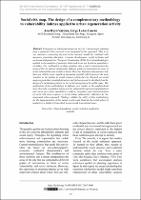Por favor, use este identificador para citar o enlazar este ítem:
https://repositorio.usj.es/handle/123456789/353
| Título : | Social risk map. The design of a complementary methodology to vulnerability indexes applied to urban regeneration activity |
| Otros títulos : | 24TH ISUF INTERNATIONAL CONFERENCE: CITY AND TERRITORY IN THE GLOBALIZATION AGE |
| Autor: | Ruiz-Varona, Ana



León Casero, Jorge 


|
| Palabras clave : | Urban degradation; Social exclusion; Qualitative methods |
| Fecha de publicación: | 2018 |
| Editorial : | UNIV POLITECNICA VALENCIA, CAMINO VERA S-N, VALENCIA, 46022, SPAIN |
| Citación : | Ruiz-Varona, A.; León-Casero, J. (2018). Social Risk Map. The design of a complementary methodology to vulnerability indexes applied to urban rehabilitation activity. En 24th ISUF International Conference. Book of Papers. Editorial Universitat Politècnica de València. 157-166. doi:10.4995/ISUF2017.2017.5060 |
| Resumen : | Conception of urban intervention in the city is increasingly mutating from a physical urban renewal to an integrated urban approach. That is to say, measures concerning physical urban renewal should be combined with measures promoting education, economic development, social inclusion and environmental protection (European Commission, 2014). Current methodologies applied to the analysis of potential distressed areas are based on quantitative variables. The combination of these variables into a matrix characterizes the areas of the city that are subjected to different grades of intervention in terms of urban vulnerability and social exclusion. However, literature demonstrates that there are still few tools capable of measuring spatially which areas are the most sensitive to the decline in social relations within the city. Research on social maps suggests that potential attractors and risk areas can be identified from the design of a methodology based on the social perception of the public space. The application of this methodology to different case studies at the neighborhood level shows the correlation between urban vulnerability approach (quantitative) and social perception (qualitative). Indeed, perception and characterization of social risk areas empowers current urban vulnerability indicators for the integrated urban approach. Findings validate the utility of this methodology for the implementation of this model to cities and illustrate the social sphere of analysis as a platform from which to assess risk in urbanized areas. |
| URI : | https://repositorio.usj.es/handle/123456789/353 |
| ISBN : | 978-84-9048-574-3 |
| Aparece en las colecciones: | Comunicaciones a congresos, conferencias |
Ficheros en este ítem:
| Fichero | Descripción | Tamaño | Formato | |
|---|---|---|---|---|
| 5060-21550-1-PB.pdf | 2,48 MB | Adobe PDF |  Visualizar/Abrir |
Este ítem está sujeto a una licencia Creative Commons Licencia Creative Commons

